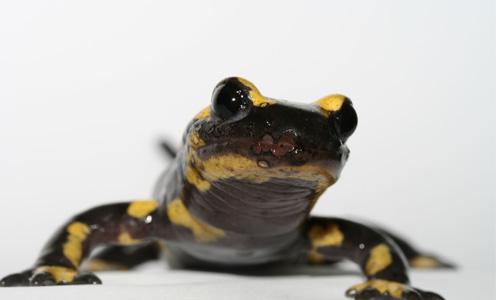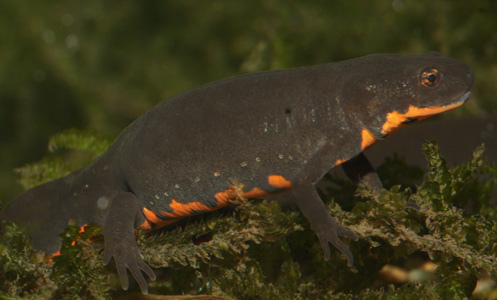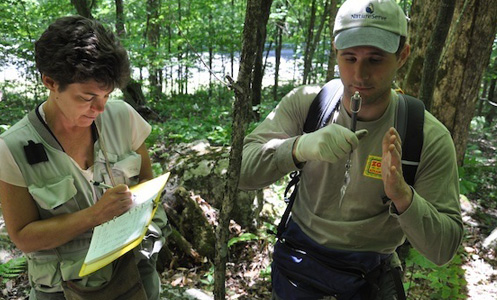SCB member Karen Lips recently contributed an op-ed to the New York Times that warns of an emerging infectious disease that is devestating salamander populations in Europe and poses a major threat to salamanders in North America should it cross the Atlantic, if it hasn't already.
Following is a Q&A with Karen, an associate professor of biology at the University of Maryland who studies salamander conservation with a focus on emerging infectious disease. Karen discusses Batrachochytrium dendrobatidis, the pathogen that is killing salamanders in Europe, and why it's important to keep it out of the U.S., a biodiversity hot spot for salamanders.
 |
|
A fire salamander, common in Europe, infected with Bsal. Photo by Frank Pasmans |
Batrachochytrium dendrobatidis, referred to here as Bsal but also known as Bs, has a 96 percent mortality rate among European salamanders and is known to be fatal to American salamanders in lab tests. It's transmission to American salamanders would most likely occur through the live animal pet trade.
Can scientists explain why Bsal is so deadly to European salamanders but not to all salamanders in Asia?
Bsal is extremely lethal to many species of salamanders, especially the family that includes newts, family Salamandridae. Newt species from Europe, Asia and America are all highly susceptible and die quickly. Some species of Asian newts do not die quickly, although they can become infected, suggesting that they may be especially important as reservoirs of disease, and could spread disease to other species. Surveys of museum specimens show that Bsal has been present in some of these species for over 150 years, suggesting that the fungus and the amphibian have coevolved with the result that the fungus is not as lethal for those species. Much more testing and surveying is needed to confirm this, but if true, it suggests that Bsal evolved in some part of Asia.
 |
|
Cynops orientalis, Chinese fire-bellied newts, are imported into the U.S. from Asia as part of the pet trade. While Bsal infects fire-bellied newts, it's not deadly to them. The newts may serve as a vector for Bsal and transmit the disease to salamanders in North America. Photo by Frank Pasmans. |
What are the most critical research imperatives right now with respect to the Bsal and its impact on amphibians, particularly salamanders?
We need to establish disease surveillance and monitoring programs in the US, and around the world where salamanders occur. We need more surveys of museum collections to understand the historic distribution of Bsal geographically and taxonomically. We need to do more extensive testing of North American salamander species to better assess susceptibility to disease and potential for population declines or spread of disease. We also need to know how losses of salamanders will affect pond, stream and forest ecosystems.
You said that preventing Bsal from reaching salamander populations in North America is a conservation and a policy challenge. Is one piece of this equation harder to get right then the other?
Over the past 25 years, the scientific community has been very successful at understanding many of the biological aspects of chytridiomycosis and impacts on amphibian populations (summarized by Collins and Crump in the book Extinction in our times: global amphibian declines). We have been much less active and effective at the conservation needs. For a thorough summary of what has been done for amphibian conservation, see the book and open-access website Conservation Evidence by Smith and Sutherland.
I was surprised at the limited numbers of published attempts, the geographic and taxonomic bias in those efforts, and the lack of any clear assessment of "success". Much work remains to be done in amphibian conservation, but we have the resources and infrastructure to do this, especially if we can collaborate with zoos, aquaria, and other conservation organizations.
Policy has received almost no attention by the amphibian community, probably because our community is comprised mostly of scientists without training in policy and uncertain about how to proceed. If we want agencies or lawmakers to take action, then we have to be willing to get involved and engage with policymakers to discuss the science behind conservation issues, whether that be wildlife disease, invasive species, climate change, etc.
Your op-ed in the NYT says that we need laws that require testing of all imported live animals to keep out those infected with pathogens or parasites. With everything we know about the spread of infectious disease why isn’t this already the norm?
Emerging infectious diseases (EIDs) are a major threat to the health of humans, wildlife and domestic animals. Bsal is just the latest - not the last - wildlife pathogen to be discovered. The rate of discovery EIDs is increasing due to the discovery of new pathogens, but also because older pathogens are emerging in new areas or new species. The increase in EIDs is a fairly recent phenomenon associated with increased globalization and increased connectivity. In the US, the Lacey Act is meant to protect our native biodiversity from injurious species. However, the Lacey Act was written over 100 years ago and was not designed to deal with pathogenic fungi or bacteria, parasites or other modern day problems. NGOs and federal agencies have recognized a gap in our existing regulatory framework that currently allows infected wildlife to enter the US. Amending the Lacey Act is one way to fill that gap, as is passage of Bills S.1153 and H.R.996.
 |
| Karen Lips with research assistant Ed Kabay. Photo by Nicholas Caruso. |
Despite massive efforts to protect amphibians from chytrid, you’ve seen firsthand the devastation that follows an outbreak, including numerous extinctions. You write about the toll this takes on biologists who have witnessed die-offs. Have these experiences influenced your approach to conservation? Why or why not?
I feel a great sense of deja vu - so much is the same as when Bd first emerged, and yet so much is different. When Bd emerged in the late 1980s nobody knew what we were dealing with, or what to do about it. It was frustrating to watch amphibians decline without knowing how to stop the problem. This time around feels different, because while much remains to be learned about Bsal, the scientific community has a big head start on the problem. We have a profile of the disease, we know a lot about its distribution, we have developed many scientific tools and research collaborations that were created for Bd that can be modified to include Bsal. Bsal is not a complete stranger to us. Many of the scientists studying amphibian disease ecology today have spent their entire career studying Bd.
On the conservation front, we have established groups that support amphibians, and several actions that can directly protect amphibians. We have also eliminated some possible causes, and ruled out some treatments and can focus our efforts on more effective procedures that reflect our growing knowledge of chytridiomycosis.
On the policy front, we have several pathways that can keep wildlife diseases out of the US and other uninfected areas and we have strong support from many stakeholders: the reception by the public, policymakers and conservation organizations are unanimous in doing what we can to keep Bsal out. I attribute this to the huge efforts by the entire community—scientists, conservationists, reporters, filmmakers, state and federal agencies —to communicate the issue, from the plight of amphibians to the threat of EIDs and the impacts on our native biodiversity and ecosystems. We have a real opportunity to successfully apply the lessons we learned from Bd to Bsal and other EIDs.
SCB recently submitted a letter to Dan Ashe, director of the U.S. Fish and Wildlife Service, that recommends the suspension of all imports of any salamander or newt that is not certified by the Service as free of Batrachochytrium dendrobatidis.